|
||||
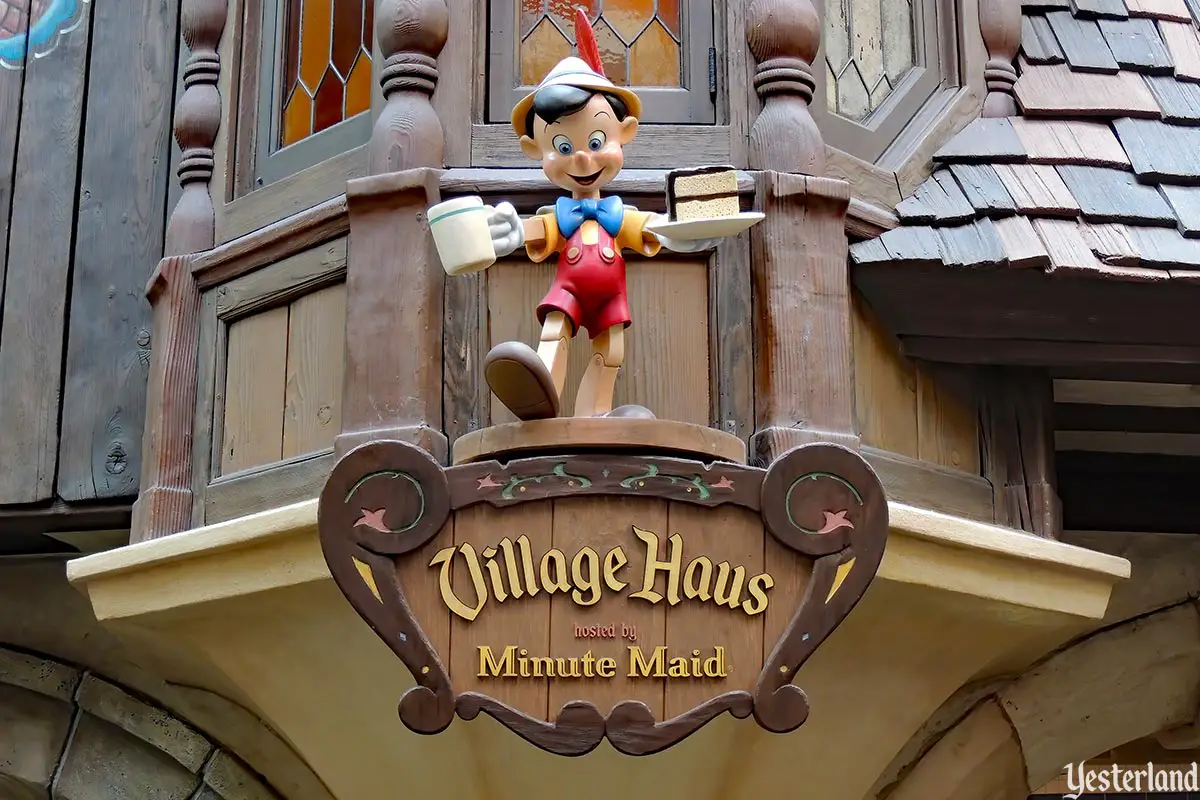
Photo by Werner Weiss, 2015 |
||||
|
Pinocchio’s Daring Journey is one of four dark rides based on classic Disney movies in Disneyland’s Fantasyland — but it has several distinctions. It’s the newest (not counting enhancements made to the others). It uses an actual hologram (in Lampwick’s mirror). It usually has the shortest wait time. And it had a restaurant attached to it, themed to the same classic movie. |
||||
|
|
||||
|
The ride is still at Disneyland, but the restaurant is now in Yesterland. Its name is just Village Haus Restaurant — not Pinocchio’s Village Haus. Pinocchio is not the owner. |
||||
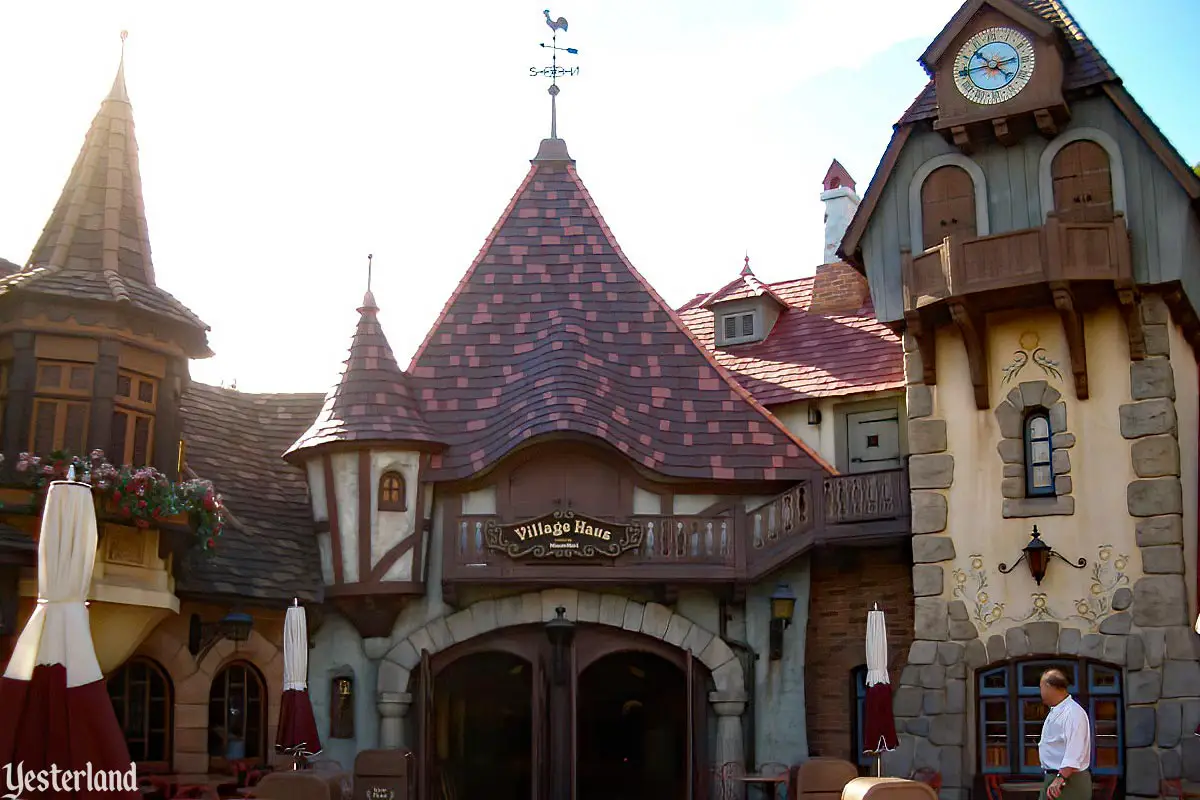
Photo by Allen Huffman, 2003 Village Haus Restaurant entrance |
||||
|
Haus is pronounced just like the English word house, not haws. In fact, haus is the German word for house. That raises the question, why is Walt Disney’s version of the Italian story Pinocchio set in the German-speaking Alps? Also, why does Pinocchio wear red Lederhosen and a Tyrolean hat with a feather? There are good answers to these questions. Walt Disney kept the story in Italy, but moved it to South Tyrol in northern Italy. Most residents there speak German. The traditional outfit is part of a culture that crosses international borders. |
||||
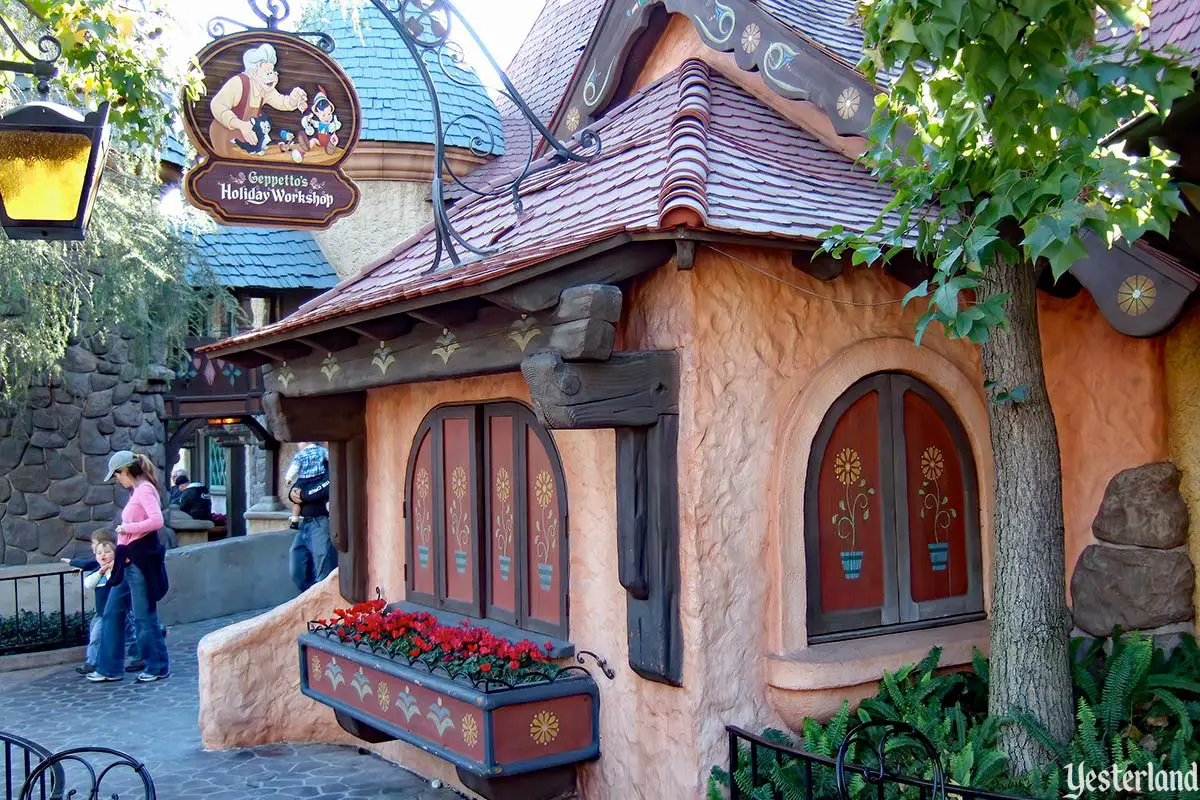
Photo by Allen Huffman, 2007 Geppetto’s workshop, located between the ride and the restaurant |
||||
|
If you’re a fan of Walt Disney’s second animated feature, Pinocchio (1940), then Village Haus Restaurant is the Yesterland restaurant for you. Before you enter, glance at Geppetto’s Holiday Workshop. Depending on when you visit, it could also be called Geppetto’s Arts & Crafts or Geppetto’s Toys & Gifts or Geppetto’s Candy Shoppe. It seems that Geppetto keeps changing his mind about what to sell in his charming shop. In any case, it’s right between Pinocchio’s Daring Journey and Village Haus Restaurant. Think of the three together as a Pinocchio mini-land within Yester-Fantasyland. Let’s go in now… |
||||
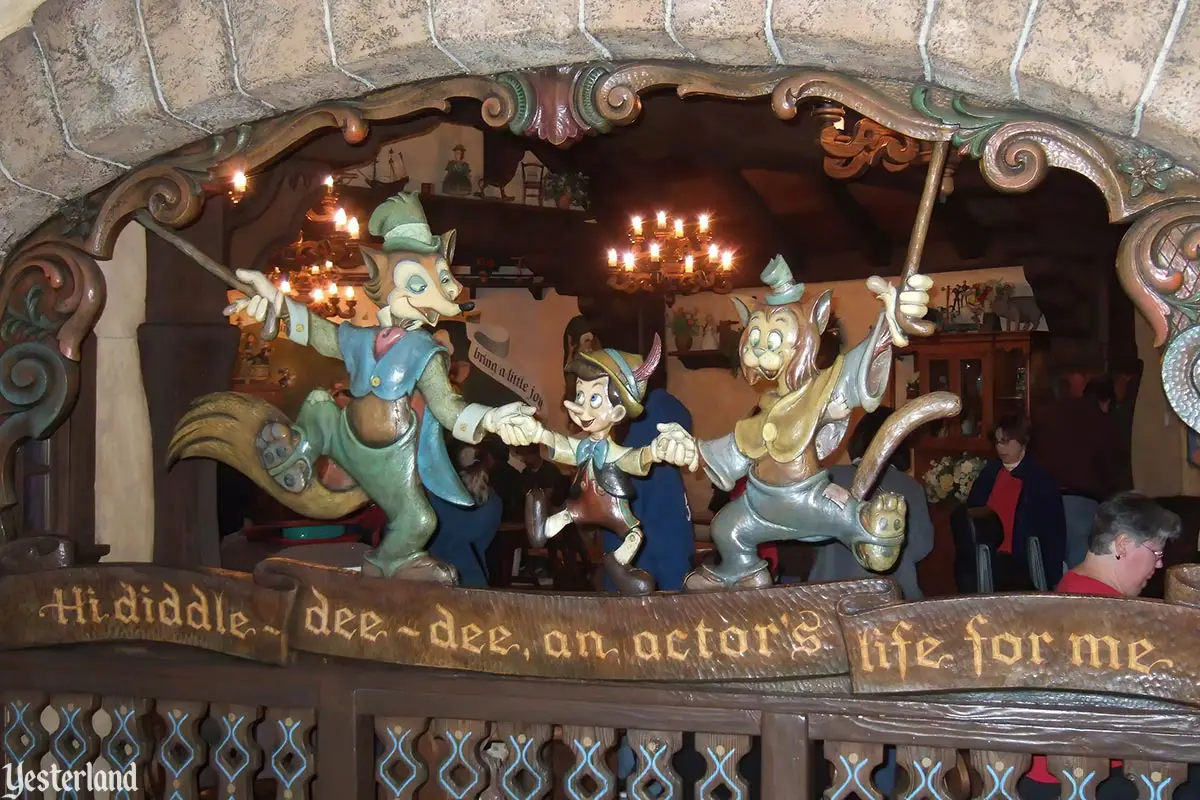
Photo by Allen Huffman, 2008 “Hi-diddle-dee-dee, an actor’s life for me” carving |
||||
|
The woodwork is wonderful — from the custom carvings, to the rustic beams, to the heavy light fixtures, to the half-timber architecture. The attention to detail is amazing. |
||||
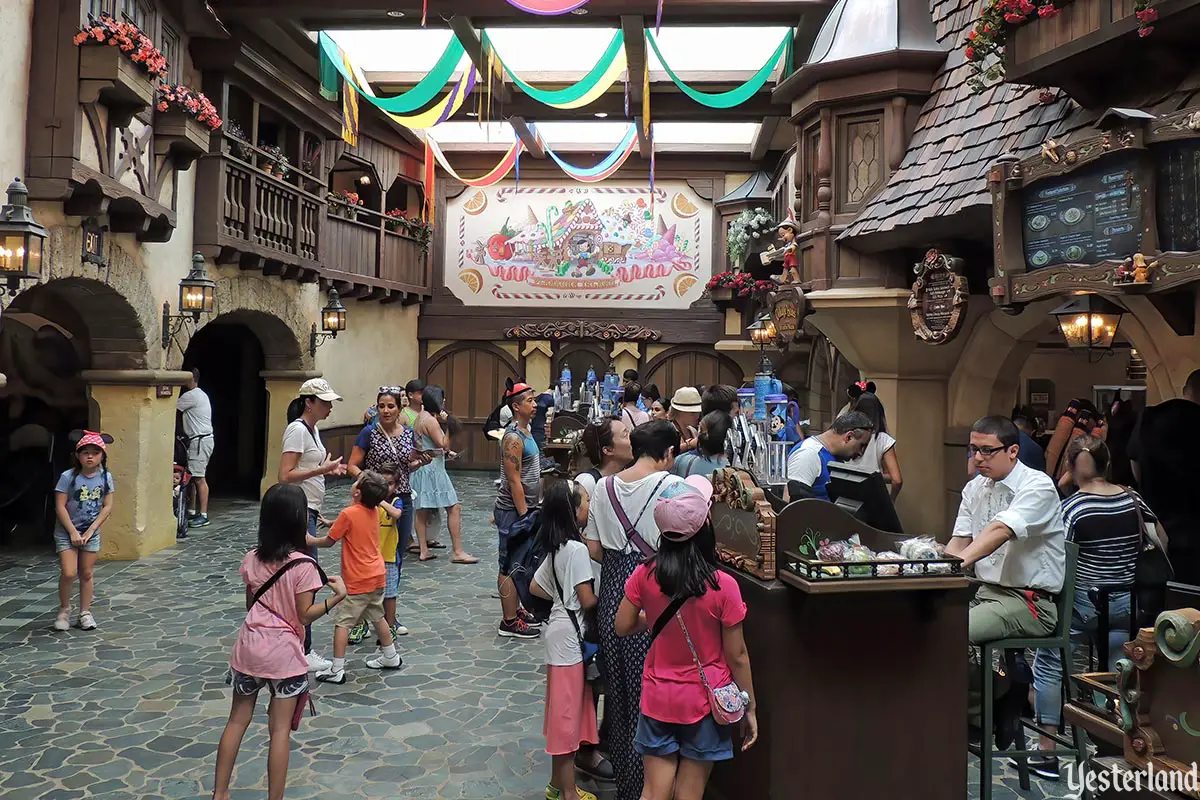
Photo by Werner Weiss, 2015 Order stations in Pinocchio’s skylit village |
||||
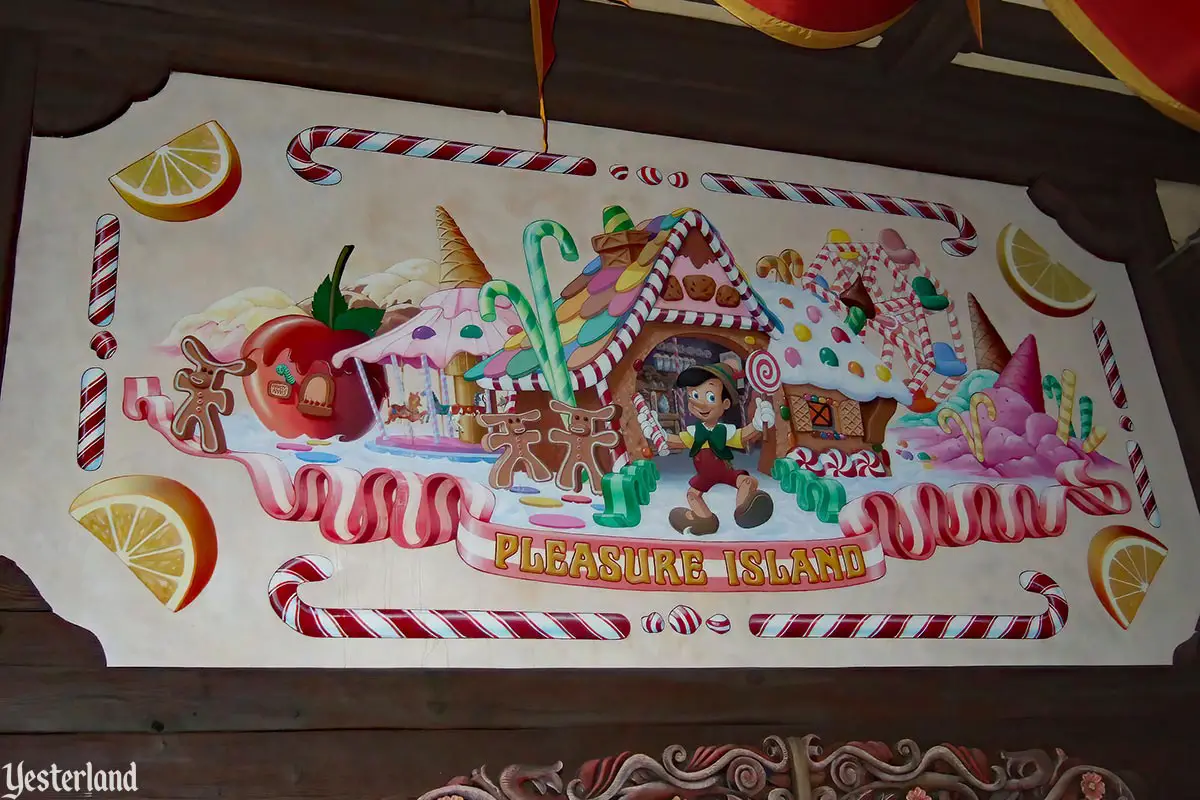
Photo by Allen Huffman, 2008 Pleasure Island mural overlooking the order stations |
||||
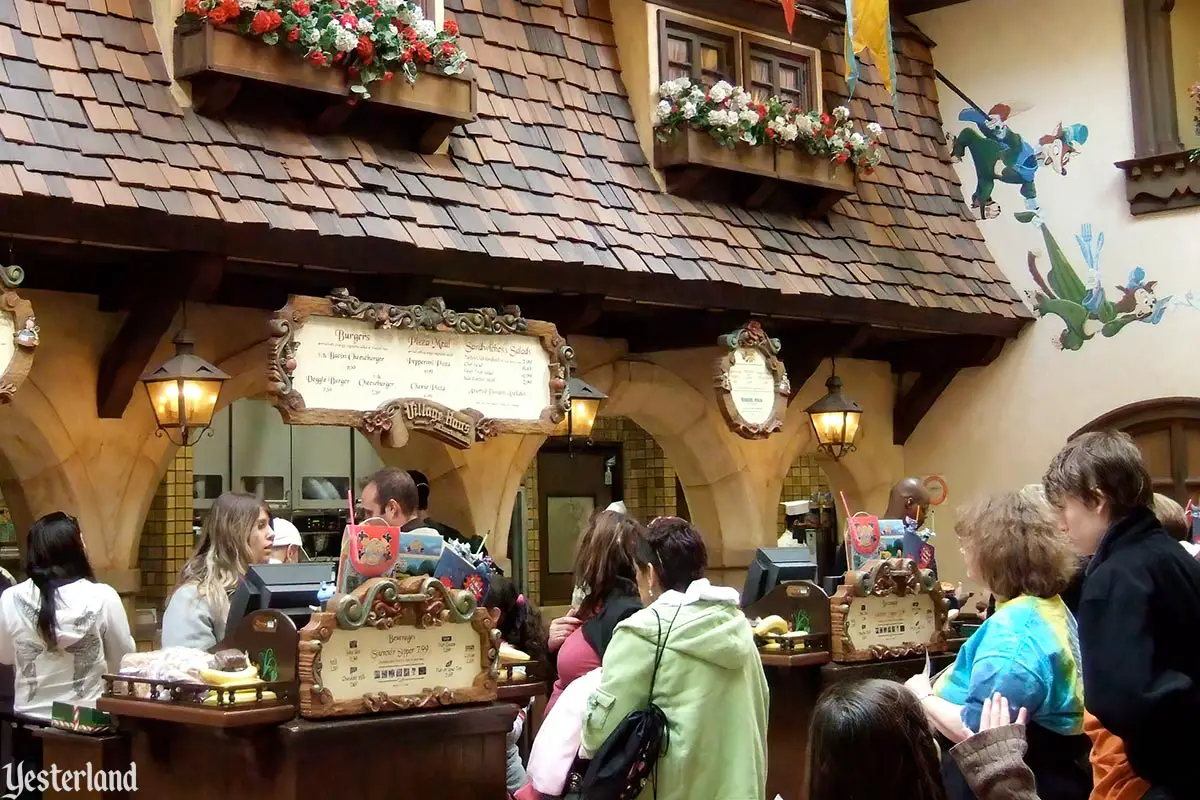
Photo by Allen Huffman, 2007 J. Worthington Foulfellow (“Honest John”) and his sidekick Gideon on the wall |
||||
|
Place your order in the bright, cheerful village square. The menu changes over time. There are always traditional cheeseburgers, pizzas, and salads — but you may encounter more interesting choices, such as an Angus 1/3 lb. Pastrami Cheeseburger with Caramelized Onions, Pickles, and Creamy Horseradish. Yum! Considering that the restaurant is hosted by Minute Maid, you might expect an extensive menu of citrus juices, drinks, and blends. Sorry. There’s Minute Maid Light Lemonade, Minute Maid juice boxes as part of kids’ meals, and Monstro Blue Frozen Lemonade. That’s all. |
||||
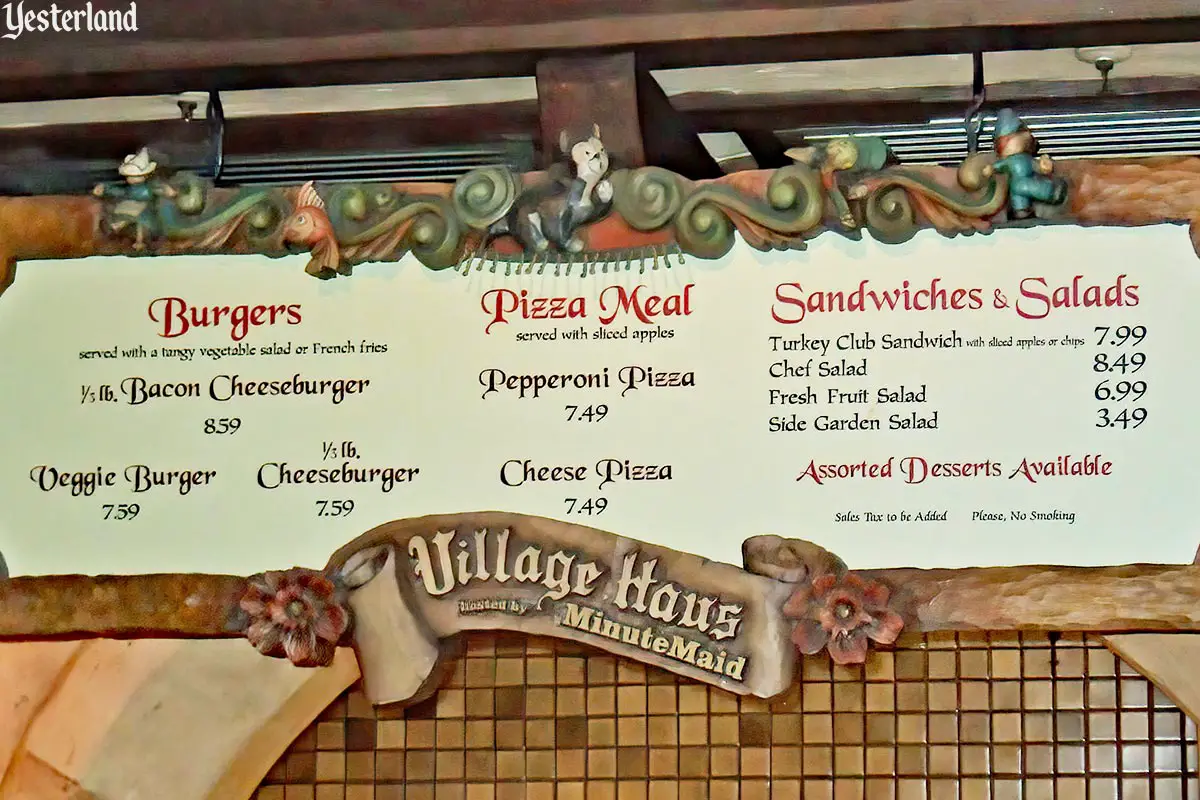
Photo by Allen Huffman, 2008 Conventional menu board in 2008 |
||||
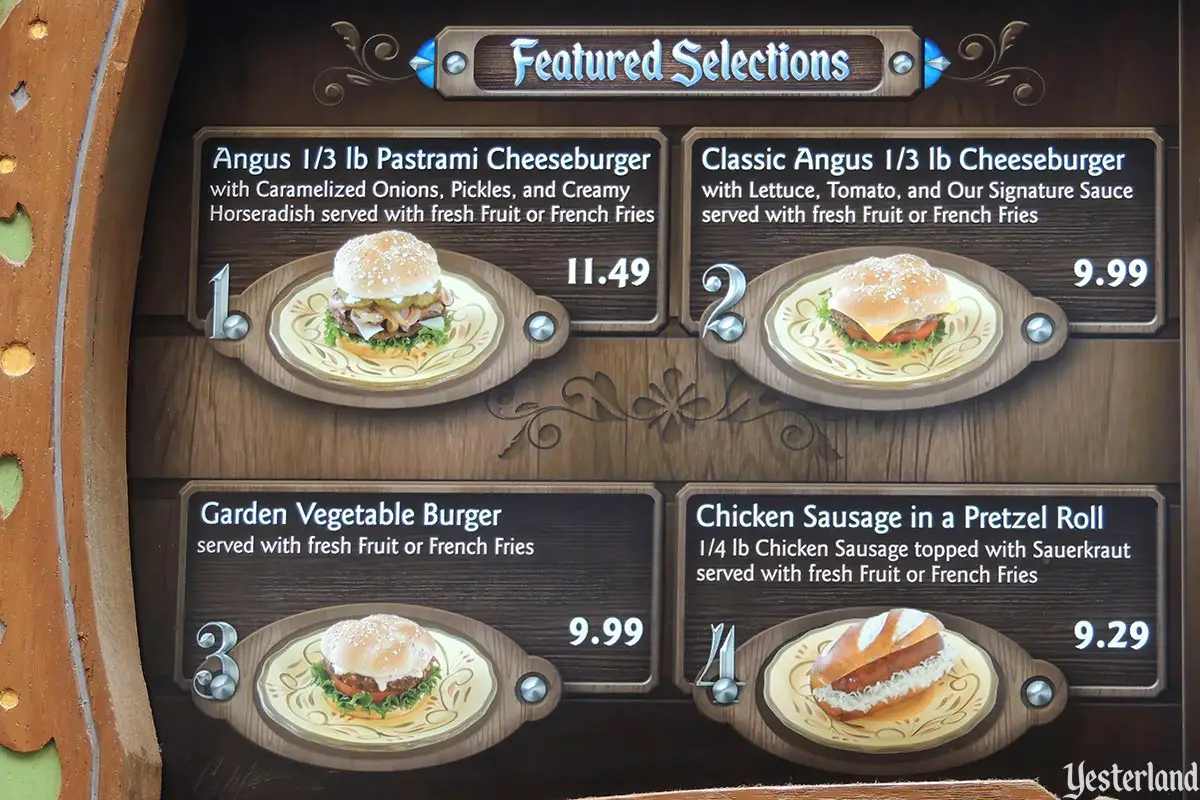
Photo by Werner Weiss, 2015 Video menu in 2015: featured selections 1 through 4 |
||||
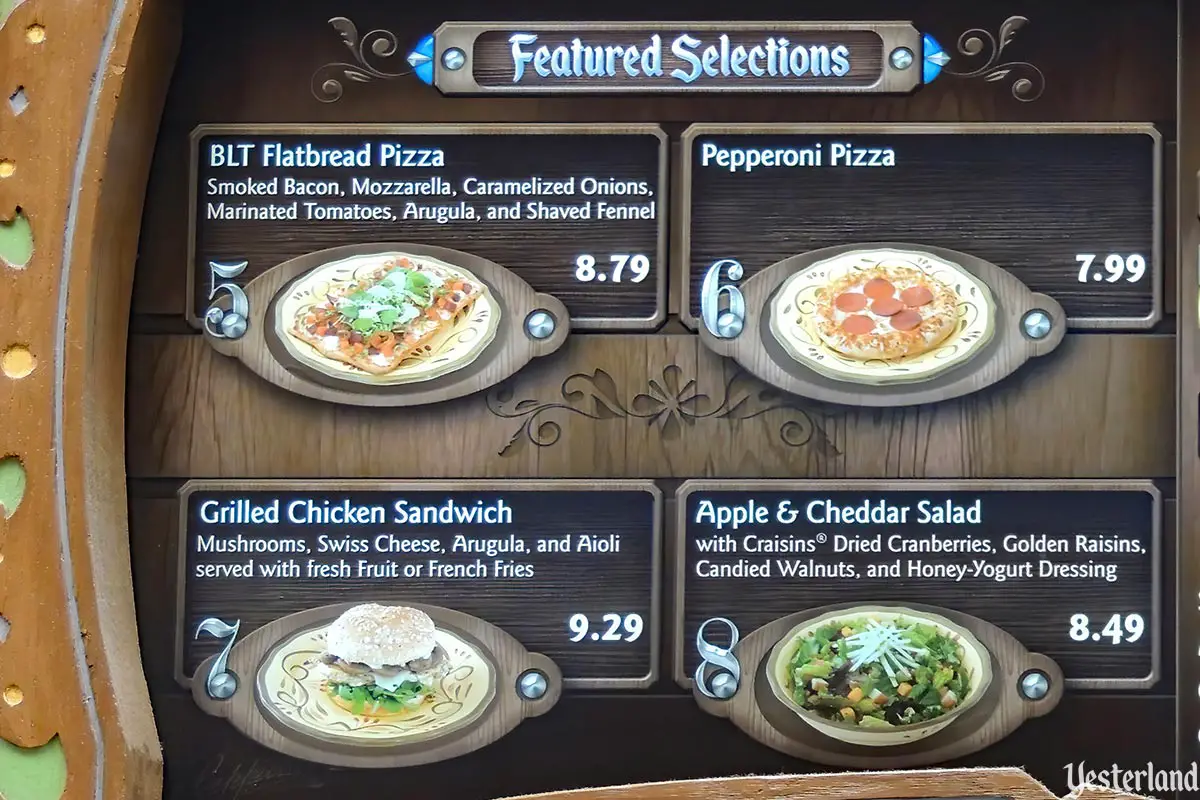
Photo by Werner Weiss, 2015 Video menu in 2015: featured selections 5 through 8 |
||||
|
Take your tray to the outdoor patio or to one of the dining rooms. Enjoy the Pinocchio decor everywhere. There are wooden toys and other knickknacks on shelves at the top of the walls and on decorative furniture. The big stars are the wonderful hand-painted murals. |
||||
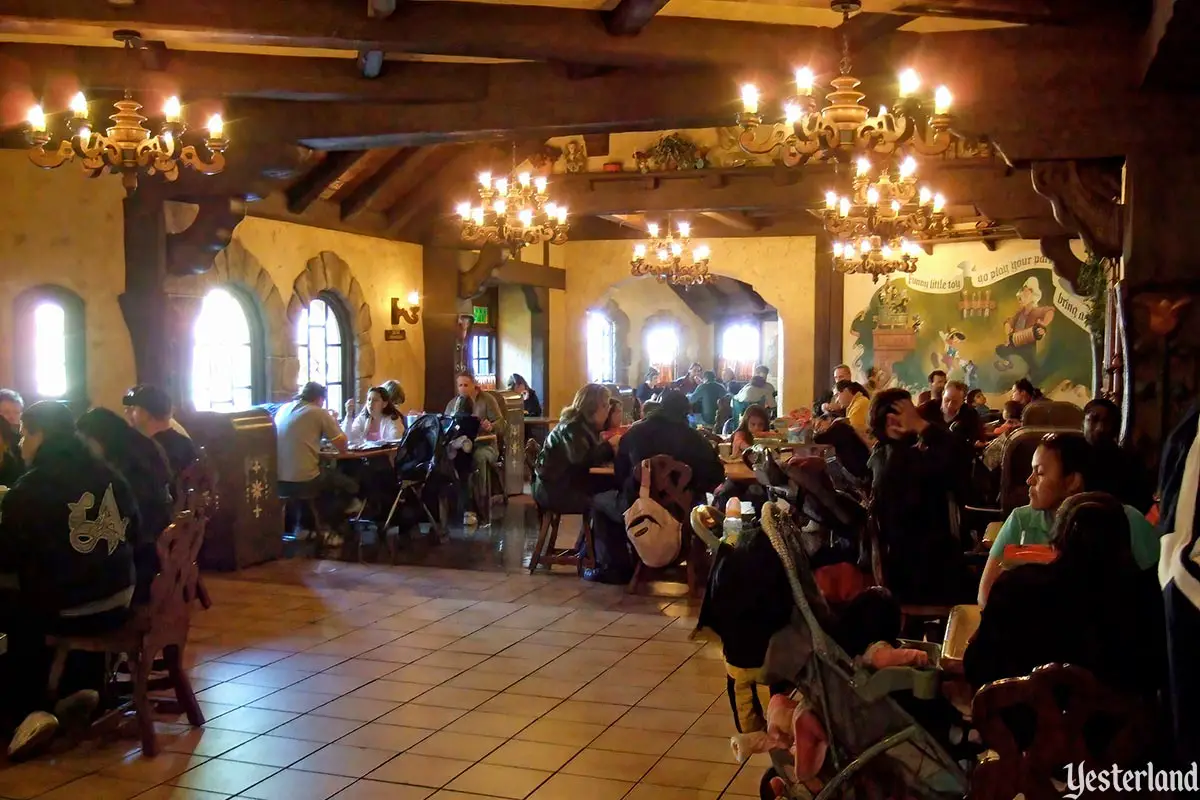
Photo by Allen Huffman, 2007 Immersive dining rooms with murals |
||||
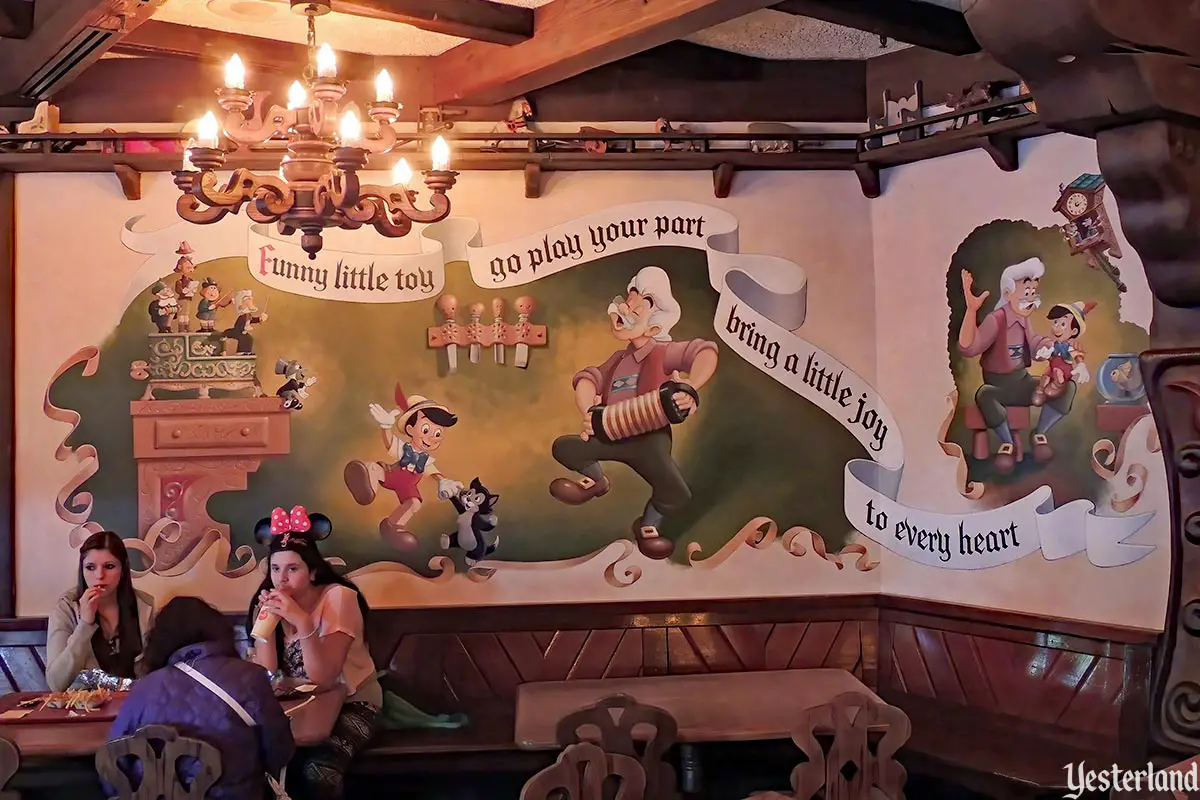
Photo by Werner Weiss, 2015 Geppetto mural |
||||
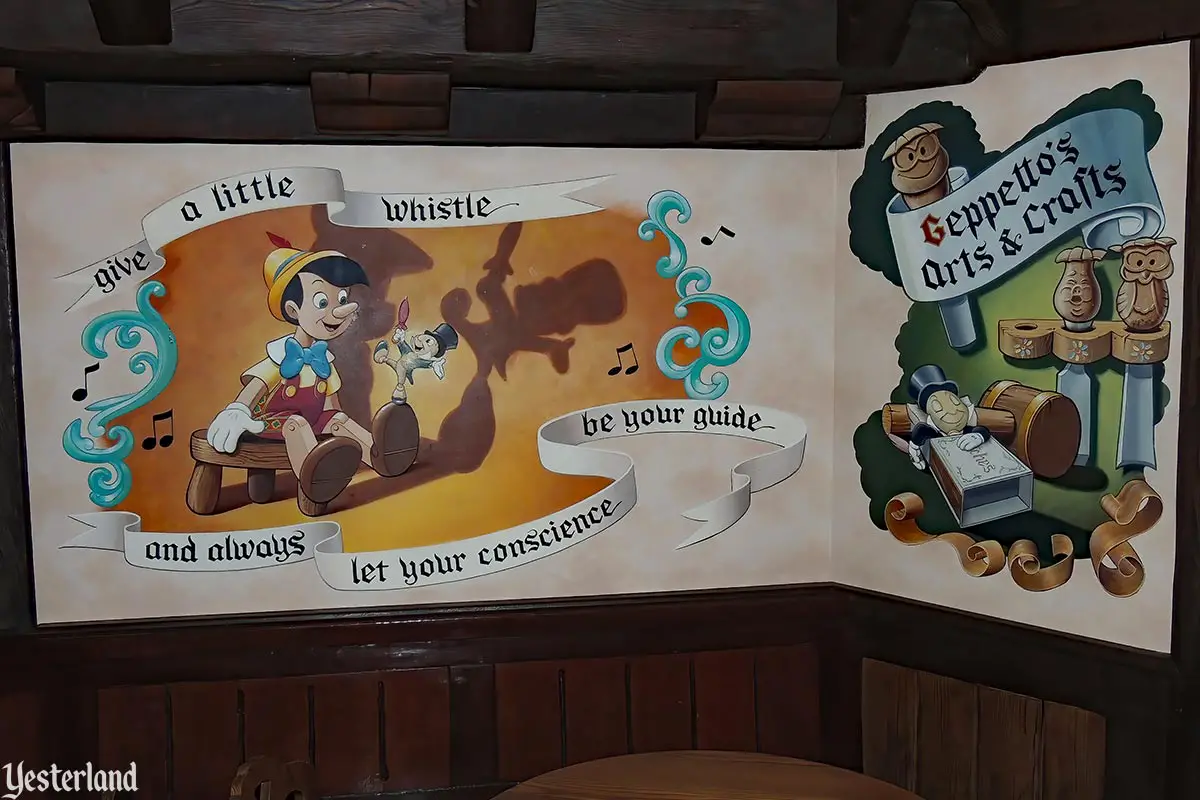
Photo by Werner Weiss, 2015 Jiminy Cricket mural |
||||
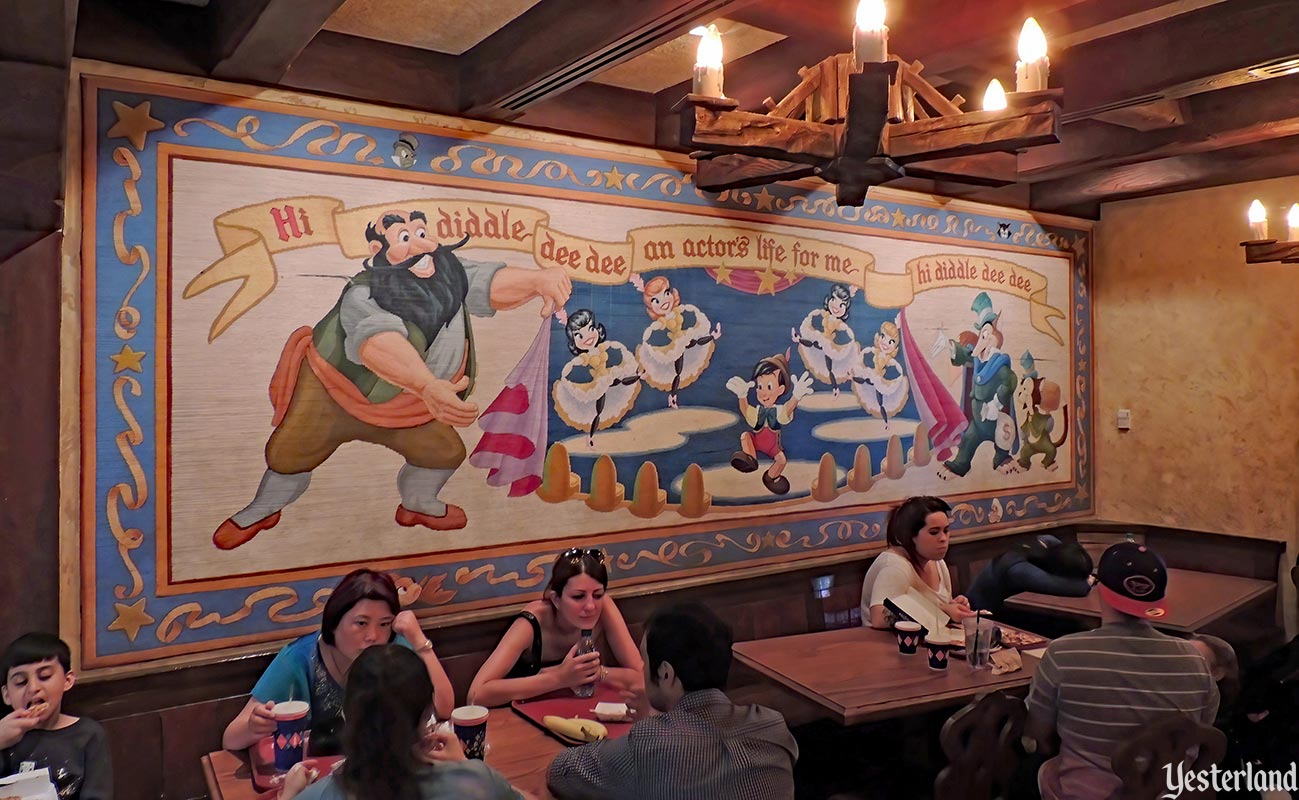
Photo by Werner Weiss, 2015 Stromboli’s marionettes mural |
||||
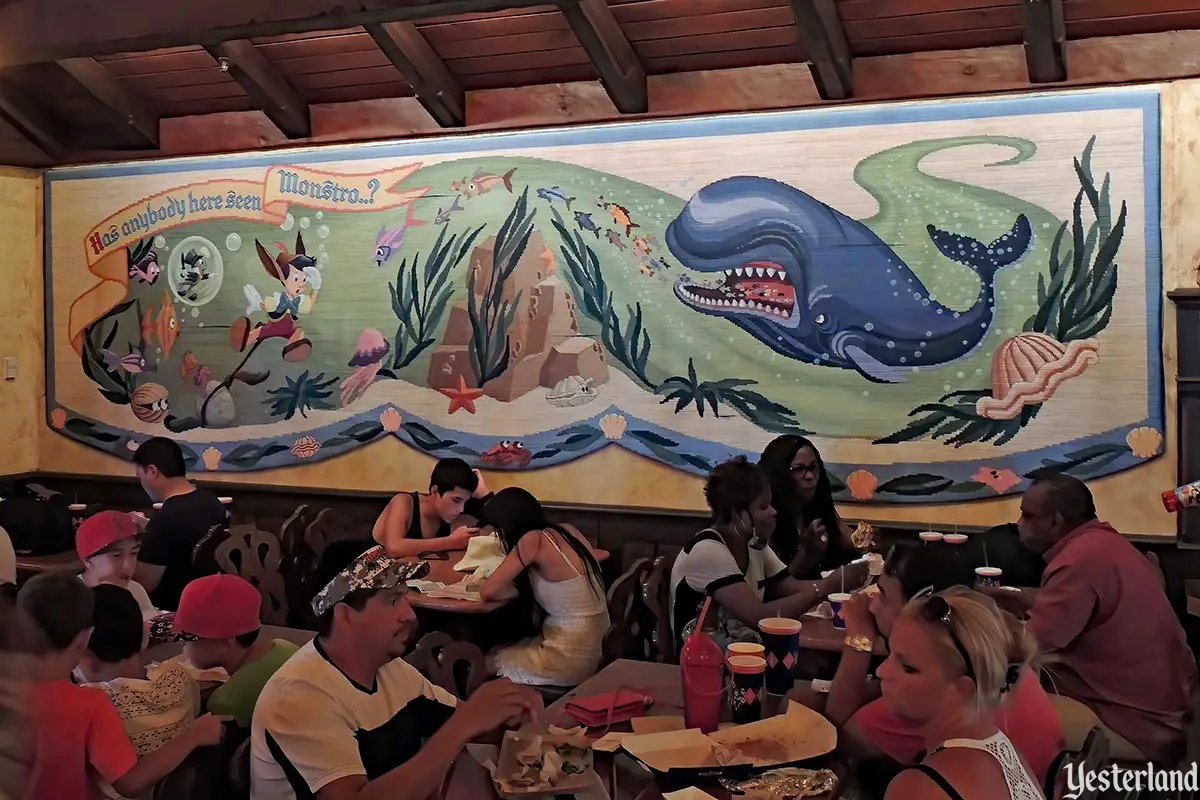
Photo by Werner Weiss, 2015 Monstro mural |
||||
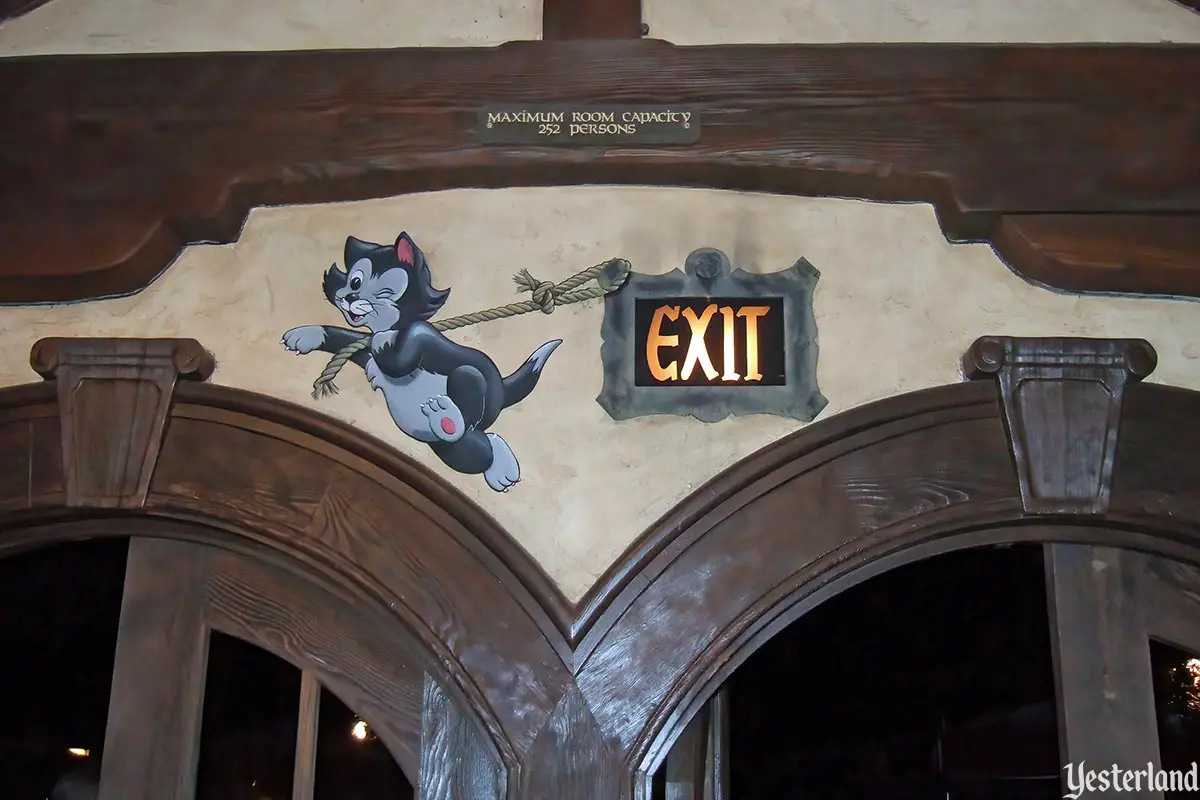
Photo by Allen Huffman, 2008 Figaro’s exit |
||||
|
Possibly the most beloved wall painting isn’t a grand mural. It’s a solution to a construction issue. When the restaurant was built, an exit sign could not be properly centered above double doors because of a vertical support between the doors. Although still effective and legal as an exit sign, it didn’t look right. Instead of rebuilding the wall to center the exit sign, a Disney artist painted Figaro, the cat from Pinocchio, trying to pull the exit sign to the correct position. Delightful! |
||||
|
|
||||
|
New Fantasyland opened at Disneyland on May 25, 1983. Gone were the medieval tournament façades from 1955, replaced by a charming Old World village. New and improved versions of Mr. Toad’s Wild Ride, Snow White’s Scary Adventures, and Peter Pan’s Flight were joined by a new neighbor, Pinocchio’s Daring Journey. Captain Hook’s Galley and its Skull Rock patio had been demolished. Fantasyland, “the happiest land of all,” would receive a new counter service restaurant and dining patio. It was called Village Inn — the perfect name for a charming Old World village eatery with a Pinocchio atmosphere. Just one problem… there was already a national chain of Village Inn restaurants. Known for its pancakes and bright orange signs, Village Inn even had locations in Disneyland’s Orange County. Disneyland’s Village Inn became Village Haus Restaurant. The original sponsor of Village Inn (and then Village Haus) was Sun Giant, known for raisins. In 1987, Castle & Cook, the parent of Dole Foods, acquired Tenneco West, the owner of Sun Giant. The Sun Giant brand was phased out. Fantasyland at Magic Kingdom Park has a counter-service restaurant with a similar name and theme — Pinocchio Village Haus. It’s been there since the park opened October 1, 1971. Located adjacent to “it’s a small world”, some tables have views of that attraction’s load area. |
||||
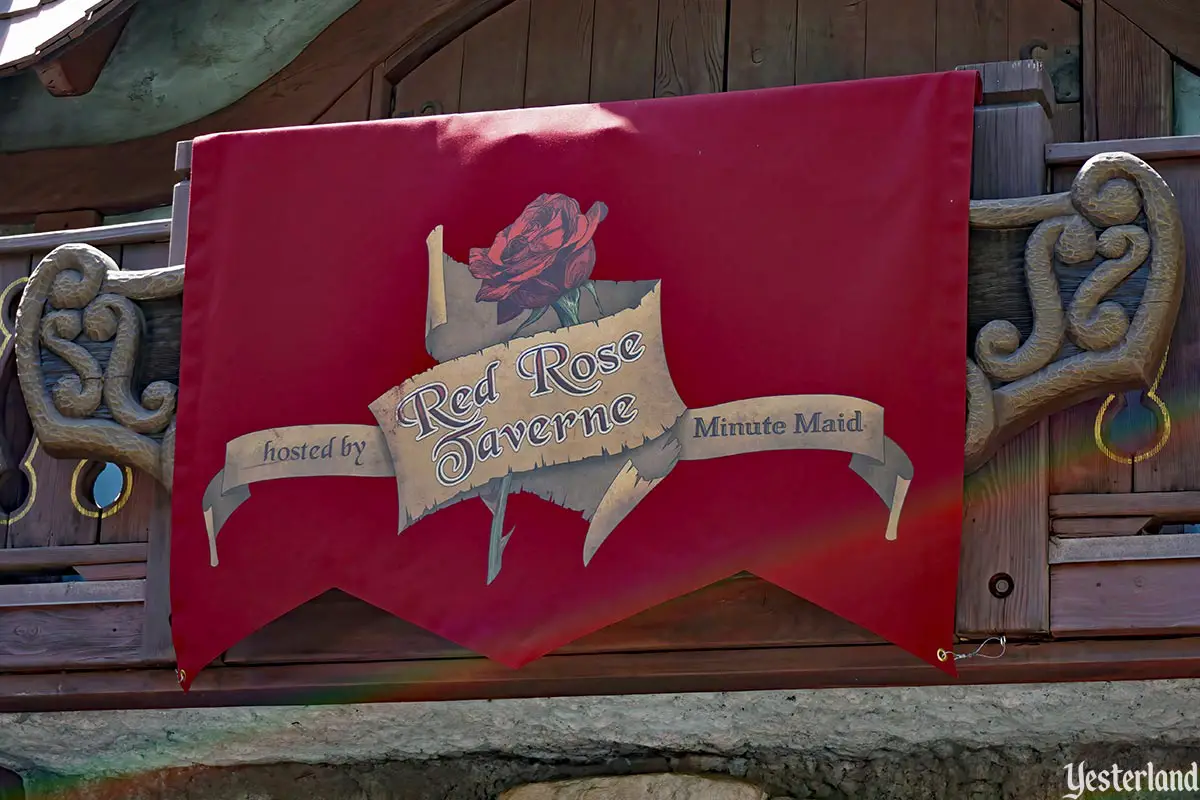
Photo by Werner Weiss, 2017 Temporary banner over the Village Haus entrance sign |
||||
|
On February 24, 2017, Disneyland’s Village Haus Restaurant became the Red Rose Taverne, promoting the March 17, 2017 release of the live-action remake of the 1991 animated masterpiece, Beauty and the Beast. The Pinocchio murals, decorative items, and stained glass were covered or replaced with Beauty and the Beast art. For an overlay that was supposed to be removed when the promotion ended, the quality was impressive. The exterior and interior architecture, woodwork, and floral artwork remained unchanged, except where Pinocchio imagery needed to be hidden. The architecture and woodwork were “generic European” enough to pass for rural France — even if a purpose-built Beauty and the Beast eatery undoubtedly would have been more authentic. |
||||
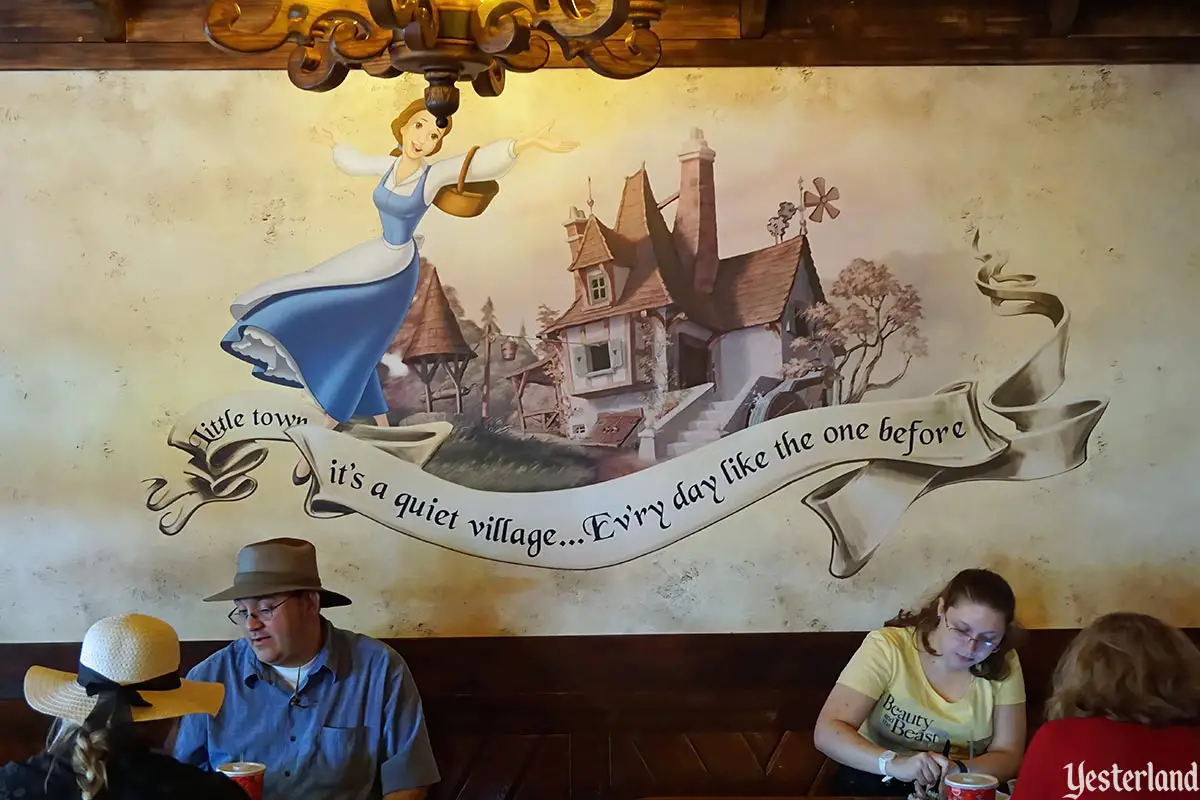
Photo by Werner Weiss, 2017 Murals with song lyrics and characters — but not from Pinocchio |
||||
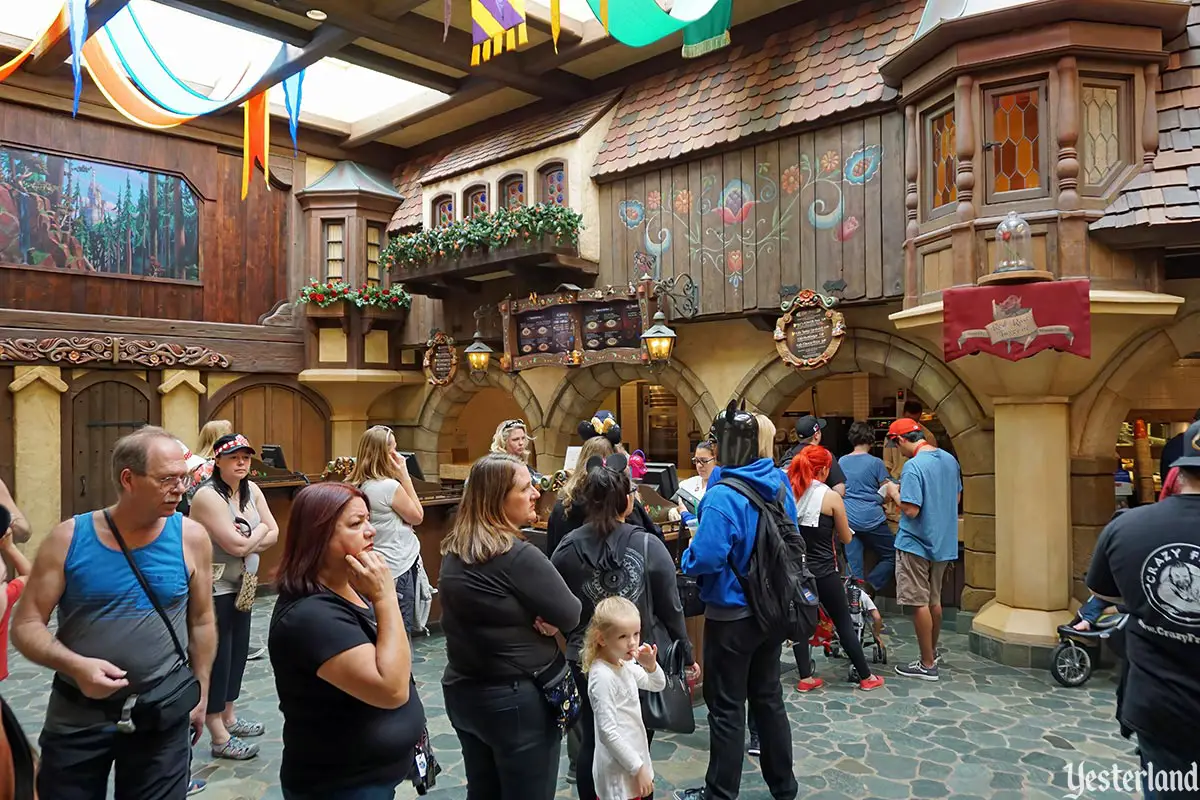
Photo by Werner Weiss, 2017 Pinocchio’s village transformed into Belle’s village |
||||
|
The new menu included such story-inspired items as the Beast’s Burger, Enchanted Cauliflower Sandwich, Slow-Cooked Beef Poutine, and Chicken Sandwich à la Lumière. For dessert, there was the Gray Stuff (“it’s delicious”). Fans were assured that the hand-painted Pinocchio murals and everything else were safe. Village Haus Restaurant would be restored to how it was before the overlay — although there was no publicly announced end date for Red Rose Taverne. Then something happened… Red Rose Taverne and the new movie were both wildly successful. Disneyland had a hit restaurant on its hands. Village Haus had been a convenient place to go when hungry — but Red Rose Taverne quickly became a “must do” destination. Fans of Beauty and the Beast waited hours to buy a $15 tumbler (limit 2) with a red rose encased inside — when it wasn’t sold out. New York magazine even ran an article, “Why Are People Freaking Out Over This Red-Rose Cup?” The 2017 version of Beauty and the Beast was an even bigger success at the box office than the 1991 original. |
||||
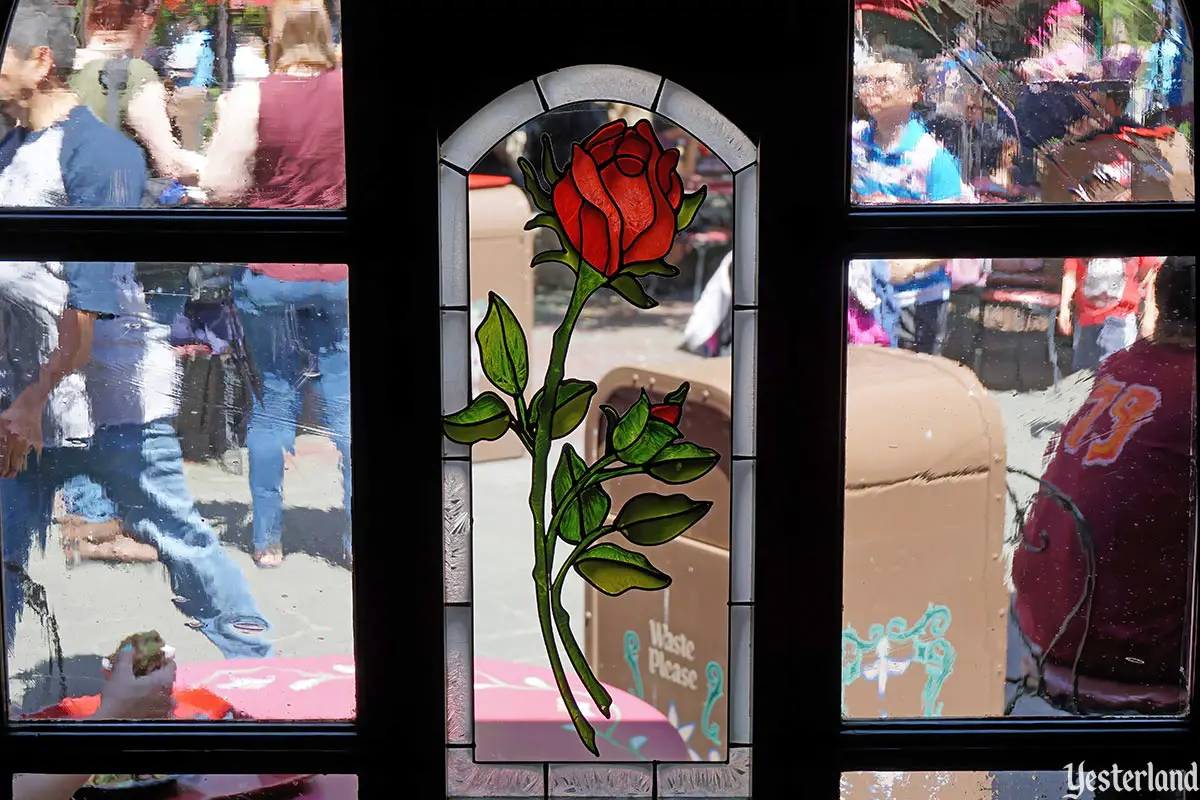
Photo by Werner Weiss, 2017 Stained glass red roses in windows |
||||
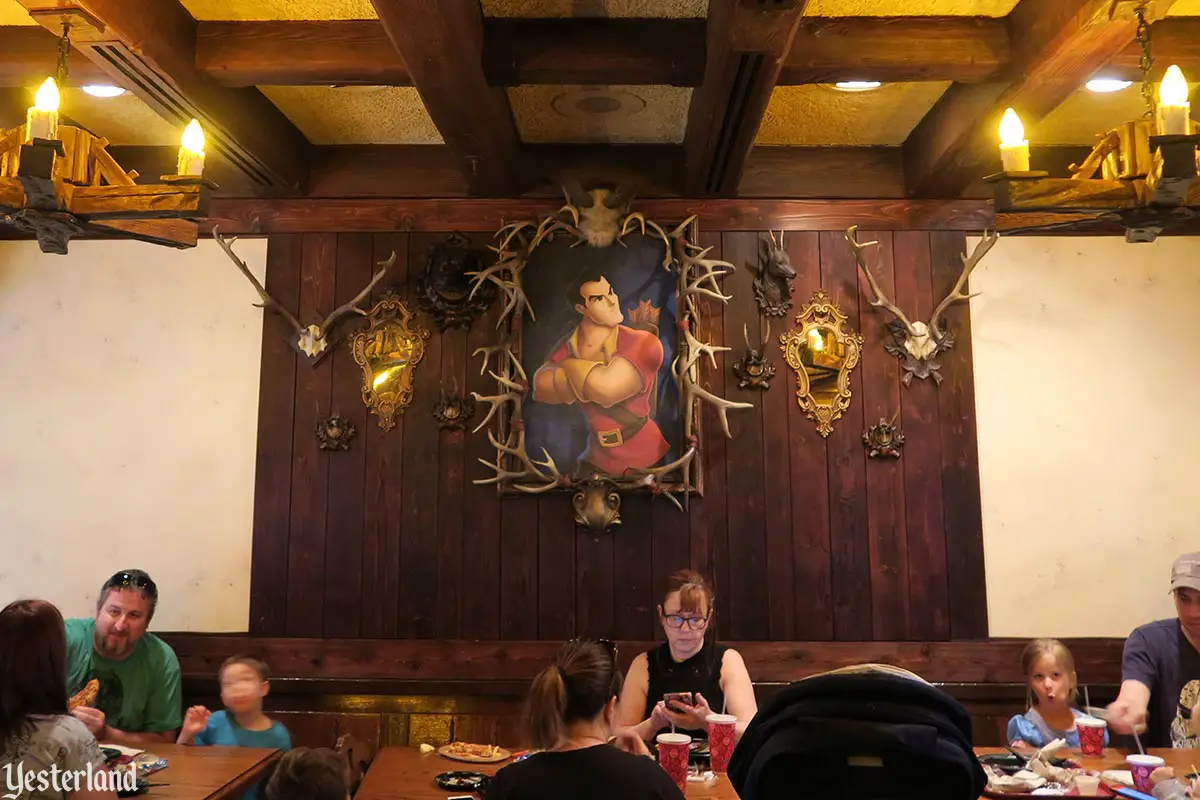
Photo by Allen Huffman, 2017 “I use antlers in all of my decorating.” |
||||
|
The “story” of Red Rose Taverne is somewhat convoluted. It’s all based on Beauty and the Beast, but not a particular location or scene from it. The antlers suggest it’s Gaston’s tavern. But why would Gaston honor the red rose from the Beast’s castle? In comparison, two separate restaurants at Magic Kingdom Park — Be Our Guest and Gaston’s Tavern — make clear distinctions between the Beast’s magnificent dining rooms and Gaston’s “manly” bar. |
||||
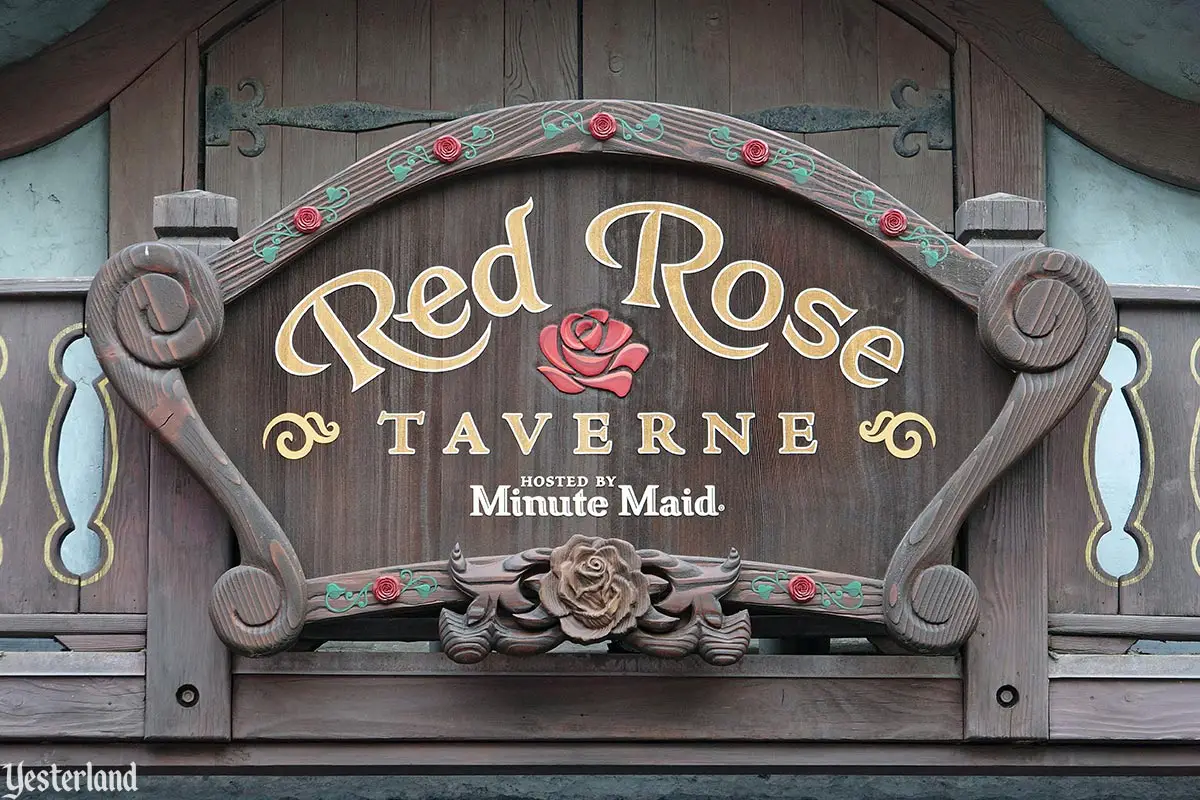
Photo by Chris Bales, 2019 Real sign for Red Rose Taverne |
||||
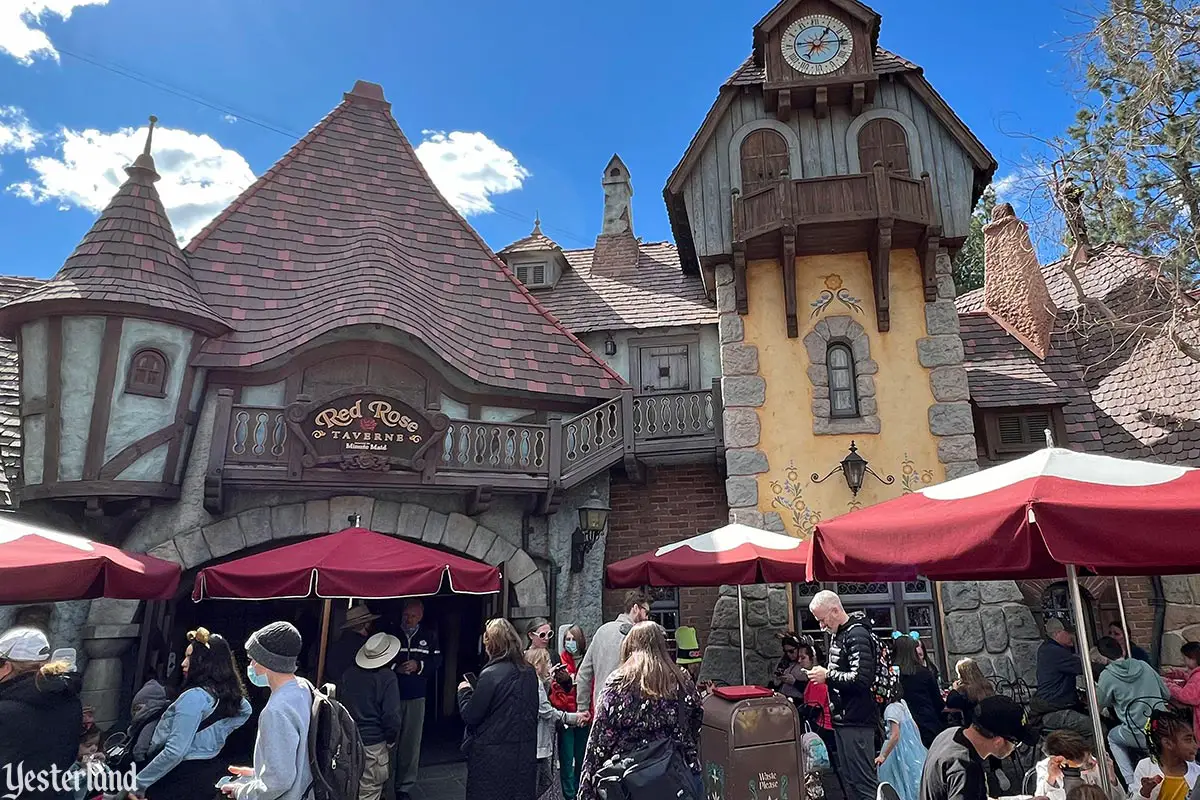
Photo by Harald Weiss, 2022 Red Rose Taverne in 2022 |
||||
|
In late 2018, Red Rose Taverne received expertly carved signs, replacing the old Village Haus signs and the banners that covered them. That settled the question of whether or not Red Rose Taverne was still just temporary. It would be nice to know that the original Village Haus Restaurant artwork and artifacts are still safe, but does it matter? Are there any circumstances that would cause a new generation of children to favor Pinocchio over Beauty and the Beast? |
||||
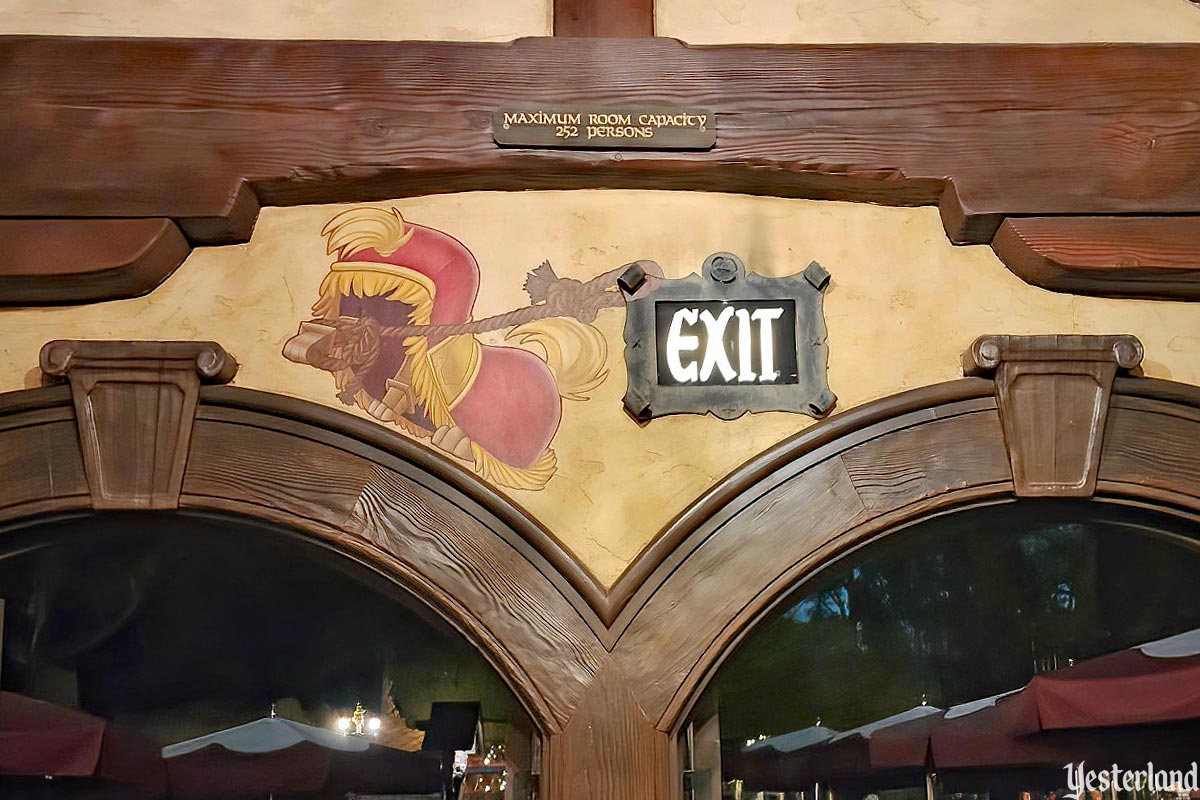
Photo by Chris Bales, 2025 Sultan’s exit |
||||
|
What about the beloved exit sign? Now it’s a dog, not a cat, pulling it. The dog is Sultan, who was turned into a footstool when the Beast’s castle was put under the spell. |
||||
|
|
Click here to post comments at MiceChat about this article.
© 2025 Werner Weiss — Disclaimers, Copyright, and Trademarks Updated February 13, 2025 |
|||